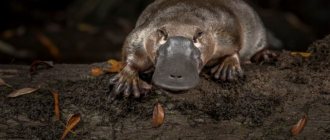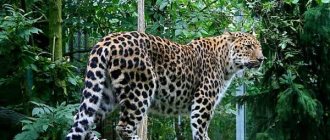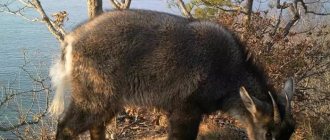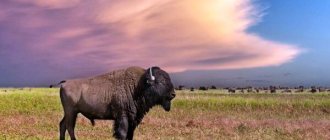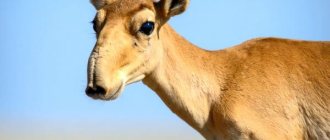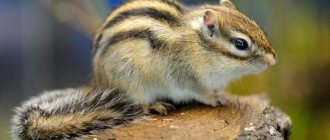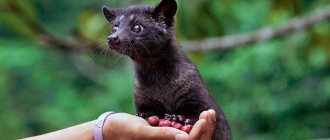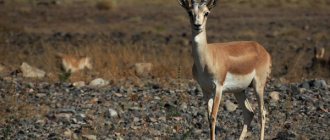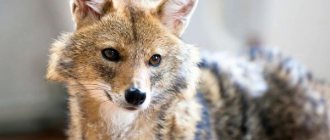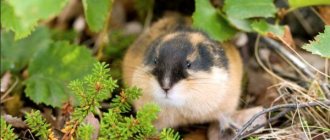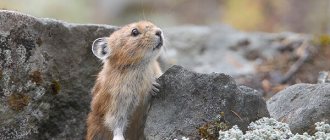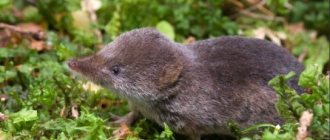- Wild animals
- >>
- Mammals
At the moment, there are only 22 kinds of pigs in the world, but out of all the large numbers, there is a separate group of animals called babirussas. Due to its unusual appearance, the babirussa or pig-deer is clearly different from all its relatives. This is a rather rare, endangered animal, with its own characteristics and limited habitat.
Origin of the species and description
Photo: Babirussa
The first mention of this amazing species was recorded in 1658; there is even an opinion that the Romans learned about the existence of babirussa in the 1st century AD. The animals received one of their first modern names in 1758. Translated from the Malay language, the word babirussa means pig-deer, but despite many differences, babirussa are very similar in appearance to pigs.
Interesting fact: According to the results of some scientific studies, it has been proven that this subspecies is closely related to hippopotamuses. Until recently, animals were classified as a single species, but after detailed studies of their differences, in the structure of the skull, teeth, size and coat.
Zoologists have identified 4 main subspecies:
- babyrousa babyrussa. This subspecies of animals, found on the islands of Buru and Sula, is generally lighter in color, thin skin, and practically without hair;
- babyrousa bolabatuensis. Animals found only on the southern part of the island of Sulawesi;
- babyrousa celebensis. Babirus Sulawesi, which grows on Sulawesi, except in the south of the island, has darker skin;
- babyrousa togeanensis. A population of individuals located on the tiny islands of the picturesque Togian archipelago.
The differences between individuals and their classification directly depend on the territorial habitat, lifestyle and their diet, however, an in-depth study of the babirussa is hampered by a sharp reduction in their population. It is reliably known that in addition to the existing species, there was another subspecies that did not survive to the present day.
Unlike their pig relatives, babirusas never burrow with their faces in the ground, except in swampy soil, live alone or in small flocks, and are considered jungle hermits.
Interesting Facts
- The aborigines of Celebes Island have various legends associated with babirussa. For example, one of them tries to explain why this creature needs such strange incisors. It’s as if she is clinging to the branches with them, hanging, and so resting in limbo. In fact, no one has ever seen this pig hanging from a tree.
- There is an assumption that the male babirussa lives only until the moment the fangs sink into his head, and in order to delay this minute, he constantly sharpens and blunts them on hard surfaces.
- For some reason, local hunters on Buru Island are sure that they need to catch this pig when it runs down the mountain. It’s as if she can only run quickly up, but she can barely go down, because in this position of her body, the internal organs put pressure on her lungs and do not allow her to breathe.
- Another interesting version is that the daily schedule of this pig depends on the phases of the moon. But in this case, we can probably only talk about animals from the island of Buru. They are the ones who react to the ebb and flow of the sea, which, as is known, are associated with the Moon. After all, their food, which they find on the shore after the water recedes, depends on this.
- Attentive readers and lovers of the works of Jules Verne may have noticed the mention of this animal in the novel “Twenty Thousand Leagues Under the Sea.” Professor Pierre Aronnax kept the babirussa and was worried about caring for her during his possible long absence.
- In Indonesia, the unusual appearance of the babirussa inspires people to create demonic masks, and the animal itself can be a gift for a guest.
Appearance and features
Photo: Babirussa pig
The main feature and distinguishing feature of these mammals from their relatives, pigs, are their unusual curved fangs. The upper canines grow throughout life, curling in front of the snout. If they are not worn out or broken, during fights with other individuals, due to the thin skin, the fangs grow into their own body, forming a ring. Such tusks can grow up to 30-40 cm and grow directly into the skull.
Video: Babirussa
Despite their menacing appearance, the fangs are quite fragile, and due to their inconvenient location, babirussas do not use them for obtaining food or as weapons. The direct purpose of these fangs has not been established exactly, but such incisors are characteristic only of males, while females have only lower canines. From the observations of zoologists, these tusks serve as an important factor for the female when choosing a partner.
Due to the unusual appearance of the fangs and the lack of accurate information about their use, local residents have unfounded legends and beliefs. According to one version, babirussu needs its fangs to cling to trees and rest in a hanging position. Others believe that the fangs correspond to the age of the animal and at the end of their life they become so long that they grow through the skull and kill the animal.
Interesting fact: There is an opinion that with the help of curled fangs the male clears the road from thickets for his family, but this theory also has not received any scientific confirmation.
Another uncharacteristic feature of pigs are long deer legs and thin bristles, which can differ in different shades and length of coat. The main skin color of these amazing animals is mainly light brown and gray tones. Regardless of the specific subspecies, the skin of all individuals is very thin and wrinkled, which makes them vulnerable, even to dogs.
Males are larger than females, but in general their dimensions are close to the size of an ordinary pig. They grow no more than 70-80 kg, up to a meter in length, have a characteristic curved back, with a small head and short ears. The only clear similarity between babirussa and pigs is their heels and the sounds they make, they communicate through grunts, squeals and jaw clattering.
Where does Babirussa live?
Photo: Babirussa in nature
Babirussa is a unique and one of the oldest species of animals on Earth, whose habitat is concentrated only on the small islands of Indonesia, namely on the islands of the Malay Archipelago:
- Sulawesi;
- Buru;
- Sula;
- Togian.
In their natural habitat, these animals can be found nowhere else. Historically, babirusas lived throughout the island of Sulawesi, but by the 19th century they had completely disappeared from the southwest of the island.
Unlike their pig relatives, these mammals do not know how to dig in the ground to look for worms, beetles and other food. Therefore, they mainly live near the banks of rivers, lakes, marshy areas, or even in mountainous areas near the sea, where nutritious vegetation can be found without much difficulty. The tropical forest has become the favorite and only home for the babirussa, where they mark their territory and move along hard paths throughout the day in search of food.
Barirussa are very vulnerable animals, therefore they live in territories free from predators, and primarily from people, climbing into the most inaccessible places of rain forests. This animal can also be found in captivity, in the central zoos of the world, where they are trying to maintain and increase the population of this unique pig.
Now you know where the babirussa animal lives. Let's see what this wild pig eats.
Danger to humans
Their appearance may suggest a danger to humans. Indeed, if you don’t know what kind of animal it is, you can mistake it for an unknown dangerous monster, which is usually used to scare people. However, in reality everything is different. It’s just humans that are much more dangerous for them. They themselves try to avoid meeting him.
In nature, there have been cases of wild pigs attacking people, but it is not a fact that they were babirussas. These pigs can pose a certain threat only at the time of feeding and raising offspring.
What does babirussa eat?
Photo: Animal babirussa
The stomach and digestive system of the babirussa are more similar to those of sheep and other chewing animals than to pigs. Animals absorb fiber well, so their main diet is herbaceous plants and shoots of shrubs, and they can stand on their hind legs, reaching leaves growing high on trees.
These are omnivores that, in addition to succulent leaves and grass, can eat:
- fruits;
- berries;
- nuts;
- mushrooms;
- fish;
- tree bark;
- flowers;
- insects;
- larvae.
But in order to feast on nutritious insect larvae or plant roots, they do not use their fangs and snout, like ordinary pigs, but dig everything out with the help of their powerful hooves. Despite their large size, babirussas are excellent swimmers; they plunge into water with pleasure, can swim across a wide river, easily cope with strong currents, feast on river fish or even small mammals. Many individuals constantly live on the sea coast, finding everything they need for their diet at the bottom of the sea, at low tide.
Little piglets feed on their mother's milk for seven or eight months, but at the age of 10 days they expand their diet with solid food. In zoos, the animals' diet includes grass, hay, lettuce, carrots, mangoes and many other vegetables and fruits.
What do strange pigs from the Indonesian islands eat?
It is worth noting that babirussas are not at all picky eaters. This creature mainly feeds on vegetation. Its digestive system is perfectly adapted to digest plant fiber.
Plant foods are the basis of the babirussa diet.
The animal seeks its food only on the surface of the earth. Babirussa will not dig the soil in search of various root crops.
Features of character and lifestyle
Photo: Babirussa wild pig
Due to the rapid decline in the babirussa population, their lifestyle and behavior are not fully known. Animals choose a difficult habitat for their own protection; they can rest and bask on rocks all day long.
Individuals live alone, a single life; females can unite in small groups consisting only of young individuals. Their main activity is observed during the day, like all pigs, they like to wallow in water, thus getting rid of skin parasites, however, unlike pigs, they do not like to pick in the dirt or make grass for themselves, but choose clean reservoirs or open areas .
Males of the babirussa tend to plow soft sand, to do this they kneel down and push their heads forward, creating a deep furrow, in the process they make snorts and growls, secreting foamy saliva. Many zoologists believe that this is how the male performs the function of aromatic marking, but there is no exact and unanimous opinion.
Despite all the danger from people, babirussas have a friendly character, easily make contact, and are quickly tamed. Living for some time in captivity, animals can show enthusiasm and excitement in the presence of familiar people, wagging their tail and head cutely. All this characterizes babirusas as sensitive and responsive animals. These good-natured animals can show aggression only in a few cases, when males fight for a female and when protecting their newborn babies.
Social structure and reproduction
Photo: Baby Babirussa
The decline in the population of this animal species is primarily due to low offspring. The female has only two mammary glands, that is, two nipples. At one time, she can give birth to no more than two cubs, which are always born of the same sex; this is another important distinguishing feature of the babirussa from its relatives, pigs.
Sexual maturity in deer pigs occurs quite quickly, at 10 months. The mating season occurs from January to August, when fights between rival males occur, which ends in mating. Pregnancy in females lasts about 5 months. Newborn babirusas do not have any protective stripes or camouflage on their skin, which makes them easy prey for predators. The female babirussa manifests itself as a responsible and caring mother, fiercely protecting her babies from any danger; in cases of alarm, she can even rush at a person.
Interesting fact: The main advantage of this species is resistance to many diseases and strong, innate immunity, which ordinary pigs cannot boast of. Despite all their unpretentiousness, breeding them is not very profitable due to the small offspring.
The lifespan of these individuals can be quite long and ranges from 20 to 25 years, but this is only possible in captivity, with proper care and nutrition. In their natural habitat, due to constant attacks from predators and poachers, animals live up to approximately 10 years.
Lifestyle
The lifestyle and behavior of the babirussa have not been fully studied. It is known that these animals are found alone or in small families on Sulawesi in swampy forests and reed thickets, on small islands, more often near the sea. Babirussa from the central part of Buru Island prefer mountainous areas, with an abundance of rocky wastelands, where they have often been observed resting directly on the rocks. Old cleavers are found mostly alone. Collecting in flocks, babirussas constantly communicate, exchanging sound signals, of which there are quite a lot. The babirussa's voice is generally close to the sounds made by other pigs - squealing, grunting, hooting, etc.
Babirussas swim well and can swim across wide rivers and even small bays. During the hottest part of the day, these pigs willingly dive into water and lie in it, but, unlike other pigs, if possible, they prefer clean ponds rather than mud puddles. When lying down, babirusas never make a bedding of grass or leaves, but lie directly on the ground.
Babirussa eats a variety of plant foods and practically does not consume animals (in the pig family, the African warthog has a similar diet). On Buru Island, however, babirusas often go ashore at low tide and pick up marine life left on the reefs and sand. The lifestyle of pigs from the coast of this island is closely related to the ebb and flow of the tides; pigs feed during low tides and rest during high waters.
Babirussas become sexually mature at the age of 10 months. The female's pregnancy lasts from 125 to 150 days. Babirusas have only two mammary glands and pigs give birth to no more than two piglets, and always of the same sex. The pig jealously guards the brood and can even rush at a suitable person. Milk feeding lasts about a month, after which the piglets begin to look for food themselves.
Babirussas live in captivity up to 24 years, but usually up to 10-12.
Nutrition
Unlike wild boars (Sus scrofa), the babirussa does not use its snout to dig up the soil when searching for food. She rarely looks for edible roots, but feeds mainly on young foliage and shoots of bushes. She is also attracted to mushrooms, ripe fruits and nuts that have fallen to the ground.
The digestive system is similar to that of ruminants, with a complex stomach with symbiotic bacteria capable of processing fiber. Babirussas do not dig in the ground to obtain food, consuming only pasture. They also actively eat tree foliage, preferring several specific species.
The vegetarian menu is periodically supplemented with various insects and their larvae. When the opportunity arises, the animal can feast on earthworms and small vertebrates.
Natural enemies of babirussa
Photo: Babirussa pig
Adult babirussa have excellent hearing and charm, which allows them to successfully escape from any threat, but like most mammals, babirussa has its enemies. Natural enemies include almost all predators living in a given area. Most often, fights between a pig-deer can occur with a tiger, and other representatives of the cat family, since for such large predators there is nothing more delicious than the tasty dietary meat of babirussa.
No less dangerous for any animal, in particular the babirussa, is the crocodile. Living in the water and coastal zone, they have an excellent reaction, thanks to which crocodiles catch any prey that approaches the water. Considering the small size and thin skin of the babirussa, it becomes an easy prey for such a giant. For small and young individuals, pythons pose a great danger, as they can attack both on land and in water. By wrapping rings and squeezing its prey, the python can swallow a fairly large individual.
However, according to many zoologists, babirusas live in an environment where there are no large predatory animals. The main enemy of the species remains man, depriving animals of their natural habitat, killing an endangered species for their own purposes.
Name
The word "babirussa" is Malay; it means "pig-deer". In the original it is written separately and with one letter “s” ( babi rusa
).
Synonyms for the scientific name of the species:
- Babyrousa alfurus (Lesson, 1827)
- Babyrousa babirousa (Jardine, 1836)
- Babyrousa babirusa (Guillemard, 1889)
- Babyrousa babirussa (Quoy & Gaimard, 1830)
- Babyrousa frosti (Thomas, 1920)
- Babyrousa indicus (Kerr, 1792)
- Babyrousa orientalis (Brisson, 1762)
- Babyrousa quadricornua Perry, 1811
Population and species status
Photo: Babirussy
Due to constant deforestation and poaching since the 90s, the population has fallen sharply and is declining every day. Despite all the prohibitions, local residents continue to hunt for this rare species, using the most merciless hunting methods, driving frightened animals into traps with the help of dogs and brutally killing them. Babirussa meat is valued due to its special taste and dietary composition. And the animal’s fangs serve as the basis for all kinds of crafts and souvenirs.
The main factors influencing the decrease in the number of babirussa:
- insufficient control over poaching;
- island population growth;
- deforestation.
Due to such disappointing statistics, at the moment there are about 4 thousand heads of animals left. There are many breeding programs around the world to increase the captive population of these wild pigs and prevent their complete extinction. In many zoos, it is quite successful not only in maintaining proper care, but also in breeding offspring in captivity. According to historical data, the first offspring in captivity were bred in Paris in 1884. By the mid-90s, babirusas became residents of almost 30 zoos around the world, with an average life expectancy in artificial conditions of 20 years. From which we can conclude that the animal gets along well with people and feels quite comfortable in captivity.
